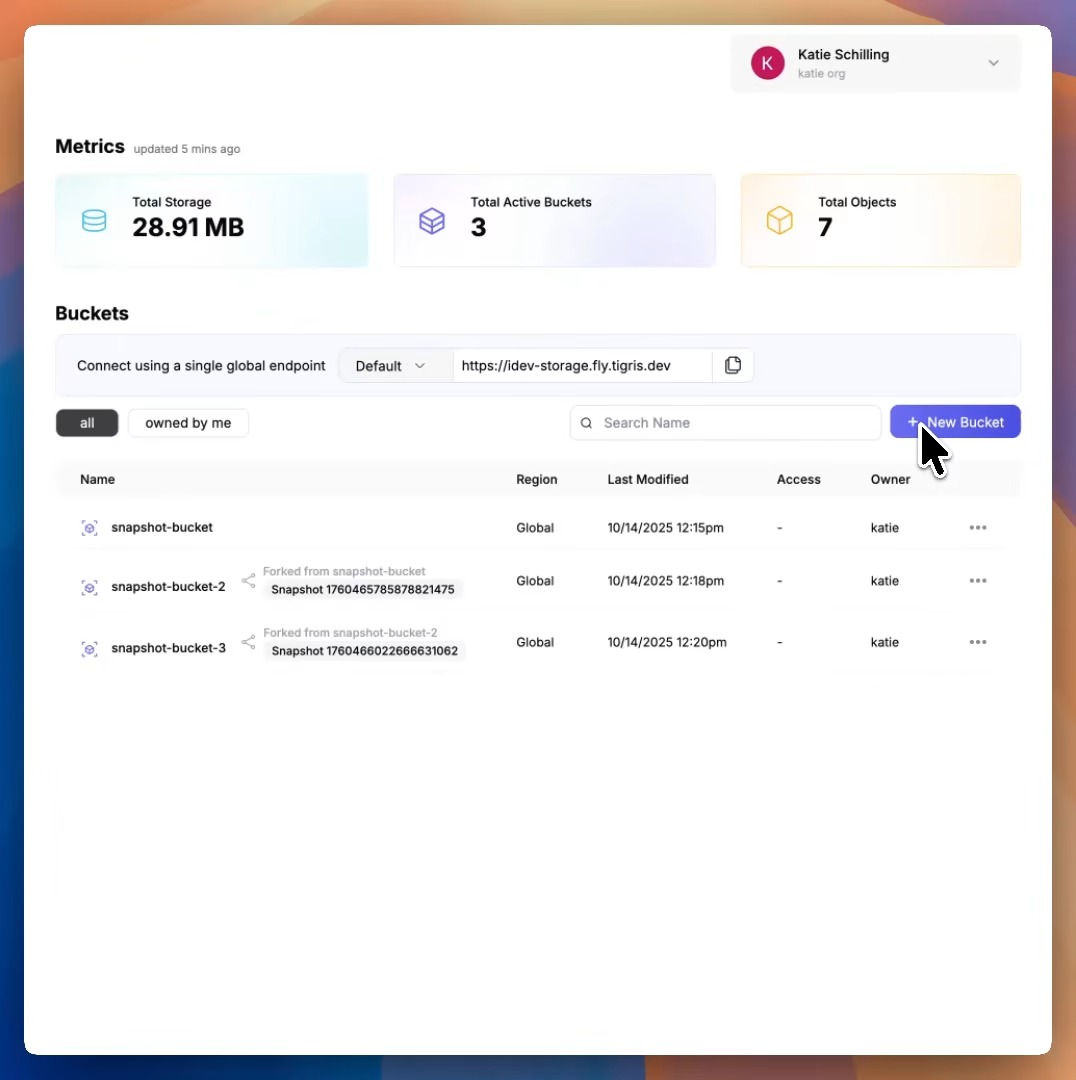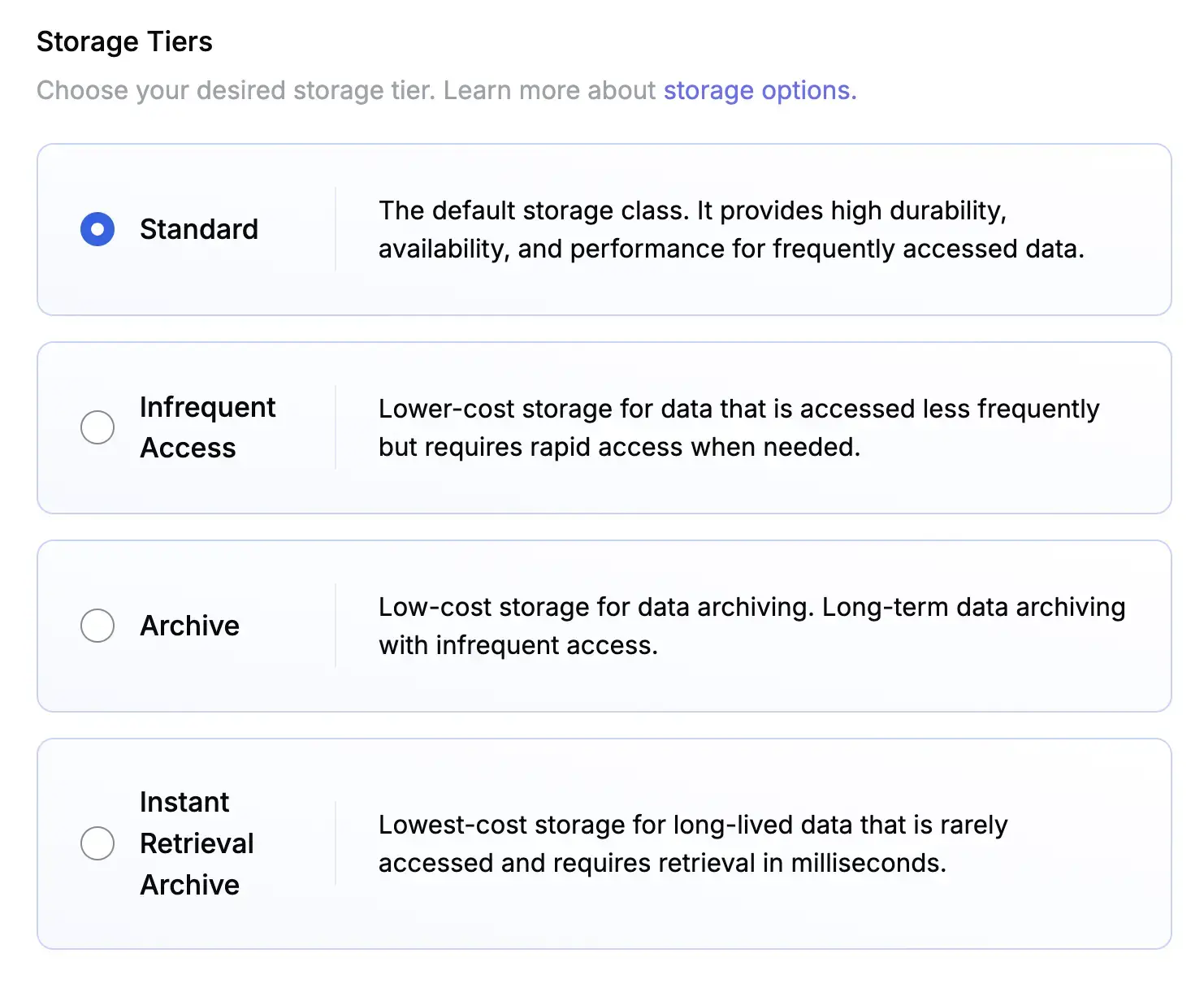Changelog
What's changed in Tigris? Look here to find out! This is where we document all of the changes to Tigris, its infrastructure, and other things that you'll find relevant for your work.
October 17, 2025
Bucket Snapshots & Forks

Tigris now supports snapshots and forks for versioning and isolating your data. Snapshots let you capture the exact state of a bucket at a specific moment in time. Forks let you clone a snapshot instantly using copy-on-write.
Why it matters
- Isolated environments for safer experimentation
- Built-in version control and reproducibility
- Reliable A/B testing and multi-model training
- Agent-friendly sandboxing
Example: Create a Snapshot Enabled Bucket and Fork It
- Python
- TypeScript
from tigris_boto3_ext import (
create_snapshot_bucket,
create_snapshot,
get_snapshot_version,
create_fork,
)
# Create a bucket
create_snapshot_bucket(s3, "my-bucket")
# Create snapshot
result = create_snapshot(s3_client, "my-bucket", snapshot_name='snappy-1')
snapshot_version = get_snapshot_version(result)
# Create a fork from the snapshot
create_fork(s3_client, "my-forked-bucket", "my-bucket", snapshot_version=snapshot_version)
import { createBucket, createBucketSnapshot, listBucketSnapshots } from "@tigrisdata/storage";
// Create a bucket
const bucketResult = await createBucket("my-bucket", {
enableSnapshot: true,
});
if (bucketResult.error) {
console.error('Error creating seed bucket:', bucketResult.error);
return;
}
// We'll omit the error handling from now on for brevity, but you should check for errors!
// Create snapshot
const snapshotResult = await createSnapshot("my-bucket", { snapshotName: "snappy-1" });
const snapshotVersion = getSnapshotVersion(snapshotResult);
// Create a fork from the snapshot
const forkResult = await createBucket("my-forked-bucket", {
sourceBucketName: "my-bucket"",
sourceBucketSnapshot: snapshotVersion,
});
Learn more: snapshots and forks documentation.
September 17, 2025
Tigris JS/TS SDK
A new JavaScript/TypeScript SDK for managing Tigris buckets and objects.
Manage your Tigris buckets and objects right from your JS/TS apps with the new @tigrisdata/storage SDK.
npm install @tigrisdata/storage
Highlights
- Full CRUD for objects — put, get, list, and remove made simple.
- Bucket management — create, list, and delete buckets programmatically.
- Browser uploads — upload files with built-in progress tracking.
Example:
import { put, get } from "@tigrisdata/storage";
await put("object.txt", "Hello, world!");
const file = await get("object.txt", "string");
Frontend upload example:
import { upload } from "@tigrisdata/storage/client";
Read more about Tigris JS/TS SDK in the docs.

Announcing the Tigris Storage SDK
Introducing the Tigris Storage SDK for JavaScript and TypeScript, a simplified alternative to AWS S3 SDK for object storage operations.
Read the BlogUI Improvements (3)
Backend Updates (1)
August 15, 2025
Org admins can enforce two-factor auth under organization settings
Administrators can configure organizations to require two-factor authentication. In order to use this, you must be using a native Tigris organization, not one created with fly.io.

Fixes (1)
Previously you were able to put any S3 or IAM action into policy documents. Tigris now enforces that these be one of the supported policy actions.
Improvements (3)
July 15, 2025
Benchmarks
We've been hearing from a lot of teams using Tigris for low-latency workloads consisting of billions of tiny files--think logs, AI feature payloads, or metadata. We published a benchmark comparing Tigris to AWS S3 and Cloudflare R2 using a mixed workload of 10 million 1 KB objects, 80% reads and 20% writes.
The results are compelling:
- Tigris is 86.6x faster than R2 and 5.3x faster than S3 at the 90th percentile for read latency.
- Throughput under mixed workloads is 4x higher than S3 and 20x higher than R2.
- Writes are consistently low-latency, with P90 latencies under 17 ms.
These gains come from architectural choices designed specifically for small-object performance: inline storage for tiny objects, log-structured caching, and coalesced key layouts that reduce IOPS pressure at scale.

Tigris Benchmark: 86× Faster Than R2 for Small Objects
Deep dive into how Tigris achieves sub-10ms read latencies and key-value store-like throughput for small object workloads. Includes detailed methodology, results, and instructions to reproduce the benchmarks yourself.
Read the BenchmarksImprovements (4)
Wanted to build your own IAM policies but didn't know where to start? Use the new IAM policy builder to make your own policies from scratch.
June 15, 2025
TigrisFS
We built TigrisFS to simplify AI data handling. If you’re working on training, inference, or pipelines, you shouldn’t have to wrestle with NFS, blobfuse, or layers of complexity just to get your storage working.
TigrisFS gives you familiar file APIs with the scale, performance, and reliability of object storage:
- No complex intermediate layers
- Use the S3 API or the Filesystem interface interchangeably
- Run globally, co-located with compute (CoreWeave, Together, Lambda, etc.)
Just mount your bucket and work with your data like it's stored locally.

TigrisFS
We've open-sourced TigrisFS — our native filesystem that makes global data from anywhere in the world instantly accessible– from your local file system.
Read the BlogImprovements (1)
May 15, 2025
Native Sign-up
You can now sign in to Tigris with Google, GitHub, or an email and password. Accounts and billing can be managed directly within Tigris, without relying on an external provider.
- User invitations: Added support for inviting users to join organizations through a new invitation flow.
- Organization management: Members can now be managed directly under Settings.
- Billing updates:
- Stripe Make a Payment option added under the Usage section
- Invoices view added
- Native billing management now available under Settings
- Membership management: Added ability to manage user membership to organizations directly within Tigris.
Improvements (2)
April 15, 2025
Object Lifecycle Rules
Configure object lifecycle rules on your bucket settings, and Tigris will automatically move data from the standard tier to an archive or infrequent access tier. Or, set an expiration rule to automatically delete data after a certain period of time.
We also added a new storage tier: Archive with instant retrieval. This is a low-cost storage tier for data that is accessed very infrequently but needs to be available quickly when needed. This is ideal for data that is needed for compliance or archival purposes but rarely accessed.

April 15, 2025
Bucket sharing
You can share your buckets with a single button in the admin console. This lets you bypass all of the IAM cruft and just give access with ease. We're surprised that adding a share button is a meaningful developer experience than juggling those IAM policies around, but we're happy to simplify your workflow.

Improvements (4)
If your app is deployed outside of Fly.io, we've launched a new high-performance endpoint just for you: https://t3.storage.dev. No access key changes required, it's got the same data you're used to, it's just much faster.
March 15, 2025
February 15, 2025
Partner Integration API
Our Partner Integration Program lets you offer Tigris as a storage service to your customers. We've published details about the API in the Partner Integrations API reference guide. This lets you handle billing, invoice management, and usage tracking for many tenants.



